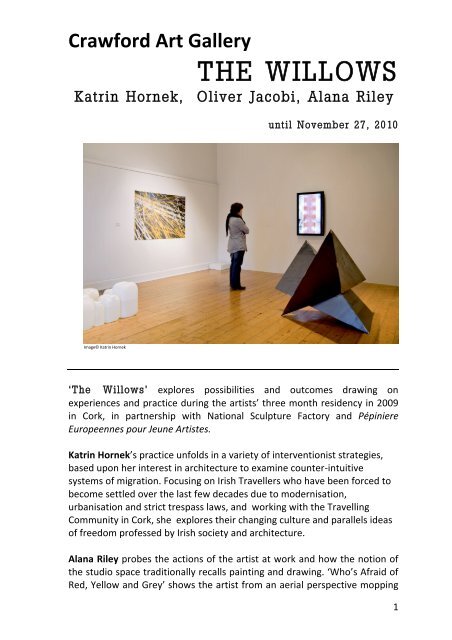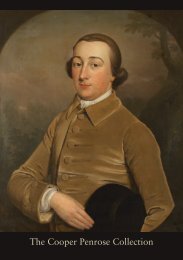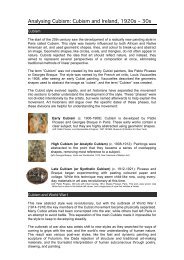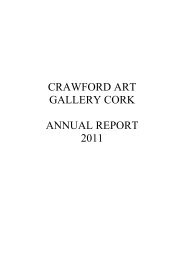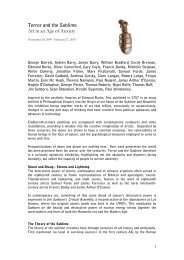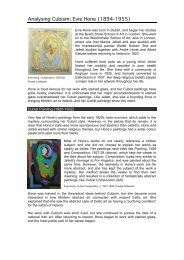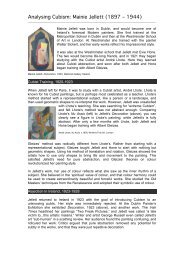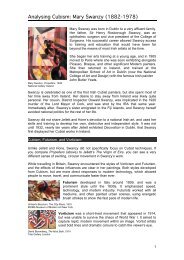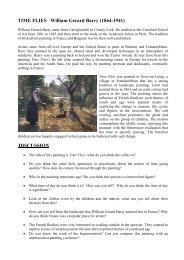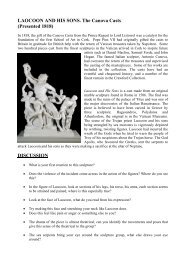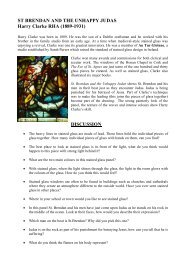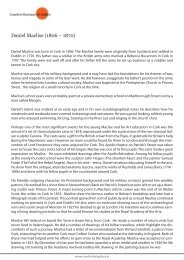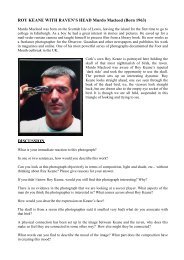THE WILLOWS - Crawford Art Gallery
THE WILLOWS - Crawford Art Gallery
THE WILLOWS - Crawford Art Gallery
Create successful ePaper yourself
Turn your PDF publications into a flip-book with our unique Google optimized e-Paper software.
<strong>Crawford</strong> <strong>Art</strong> <strong>Gallery</strong> <br />
<br />
<br />
<strong>THE</strong> <strong>WILLOWS</strong><br />
Katrin Hornek, Oliver Jacobi, Alana Riley<br />
until November 27, 2010<br />
Image© Katrin Hornek <br />
<br />
<br />
‘The Willows’ explores possibilities and outcomes drawing on <br />
experiences and practice during the artists’ three month residency in 2009 <br />
in Cork, in partnership with National Sculpture Factory and Pépiniere <br />
Europeennes pour Jeune <strong>Art</strong>istes. <br />
<br />
Katrin Hornek’s practice unfolds in a variety of interventionist strategies, <br />
based upon her interest in architecture to examine counter‐intuitive <br />
systems of migration. Focusing on Irish Travellers who have been forced to <br />
become settled over the last few decades due to modernisation, <br />
urbanisation and strict trespass laws, and working with the Travelling <br />
Community in Cork, she explores their changing culture and parallels ideas <br />
of freedom professed by Irish society and architecture. <br />
<br />
Alana Riley probes the actions of the artist at work and how the notion of <br />
the studio space traditionally recalls painting and drawing. ‘Who’s Afraid of <br />
Red, Yellow and Grey’ shows the artist from an aerial perspective mopping <br />
1
the studio floor. Whilst alluding to colour‐field painting in her performance, <br />
Riley comments on general perceptions of the artist and the differing values <br />
society places on labour. <br />
<br />
Oliver Jacobi’s work revolves around a physical manipulation of <br />
architectural spatial conditions and specifically appearing to alter <br />
immutable mathematical laws. His sculptural and architectural <br />
interventions manifest his interest in diverse materials, and the viewer’s <br />
unpredictable response is pivotal to his practice. Jacobi has made a series <br />
of three sculptures for ‘The Willows’ with the third situated in the Sculpture <br />
Galleries (Ground Floor). <br />
<br />
Catalogue launch & guided tour: <br />
Thursday 18 November by Dr Ed Krčma (University College Cork), 5:30 pm <br />
<br />
<br />
KATRIN HORNEK (b. 1983, Austria) <br />
<br />
‘Hornek creates and follows flows of material and information as they pass from the world into her work <br />
and out again. This is an architecture of movements, because for Hornek a space is not defined by its walls, <br />
but by the systems that inhabit and animate it. This makes architecture a political construction, both an <br />
expression of the systems of which it is a part, and a mechanism by which these wider social forces can be <br />
questioned, challenged and possibly rebuilt. In this way Hornek explores space as a kind of interface, as a <br />
process connecting and disconnecting specific localities from the global forces that structure and striate <br />
them.” <br />
Steven Zepke, 2009 <br />
www.katrinhornek.com <br />
<br />
OLIVER JACOBI (b. 1973, Germany) <br />
<br />
“Most of my work is installation. I try to arrange works which produce rather precise personnel <br />
experiences. They do not deal with the perception of a society or a group but as a sort of self portrait, with <br />
the perception of a single individual. I infer from myself to others. The piece, the object or the installation <br />
can have the characteristics of a system. I am interested in what happens, when a work becomes an <br />
opponent which makes you feel attracted, rejected or both in a physical way. One becomes conscious of <br />
such feelings the best way if one moves in a space, or if one acts physically”. Oliver Jacobi, 2010 <br />
www.oliverjacobi.wordpress.com <br />
<br />
<br />
ALANA RILEY (b. 1975, Canada) <br />
<br />
“Using photography and video, I seek to examine the ways in which we function within our social <br />
environments; how we relate to one another, both in intimate contexts and within society at large. My <br />
concepts emerge from questions of identity construction, and my interest in the role of the portrait. I <br />
often focus on the workplace as a site of intervention and contemplation. Engaging within this <br />
environment allows me to investigate how our daily actions shape our personal identity. By setting‐up <br />
situations and interactions that would not normally occur in the everyday, I attempt to dramatize the <br />
relationships that form the undercurrent of our everyday lives”. Alana Riley, 2010 <br />
<br />
www.alanariley.com <br />
<br />
<br />
<br />
www.crawfordartgallery.ie <br />
2


